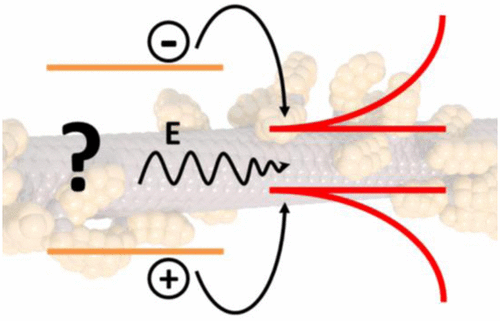当前位置:
X-MOL 学术
›
J. Phys. Chem. Lett.
›
论文详情
Our official English website, www.x-mol.net, welcomes your
feedback! (Note: you will need to create a separate account there.)
Excited-State Interaction of Semiconducting Single-Walled Carbon Nanotubes with Their Wrapping Polymers
The Journal of Physical Chemistry Letters ( IF 4.8 ) Pub Date : 2017-11-08 00:00:00 , DOI: 10.1021/acs.jpclett.7b02553 Simon Kahmann 1, 2 , Jorge M. Salazar Rios 1 , Matthias Zink 3 , Sybille Allard 3 , Ullrich Scherf 3 , Maria C. dos Santos 1 , Christoph J. Brabec 2, 4 , Maria A. Loi 1
The Journal of Physical Chemistry Letters ( IF 4.8 ) Pub Date : 2017-11-08 00:00:00 , DOI: 10.1021/acs.jpclett.7b02553 Simon Kahmann 1, 2 , Jorge M. Salazar Rios 1 , Matthias Zink 3 , Sybille Allard 3 , Ullrich Scherf 3 , Maria C. dos Santos 1 , Christoph J. Brabec 2, 4 , Maria A. Loi 1
Affiliation

|
We employ photoluminescence and pump–probe spectroscopy on films of semiconducting single-walled carbon nanotubes (CNTs) of different chirality wrapped with either a wide band gap polyfluorene derivative (PF12) or a polythiophene with narrower gap (P3DDT) to elucidate the excited states’ interplay between the two materials. Excitation above the polymer band gap gives way to an ultrafast electron transfer from both polymers toward the CNTs. By monitoring the hole polaron on the polymer via its mid infrared signature, we show that also illumination below the polymer band gap leads to the formation of this fingerprint and infer that holes are also transferred toward the polymer. As this contradicts the standard way of discussing the involved energy levels, we propose that polymer-wrapped CNTs should be considered as a single hybrid system, exhibiting states shared between the two components. This proposition is validated through quantum chemical calculations that show hybridization of the first excited states, especially for the thiophene–CNT sample.
中文翻译:

半导体单壁碳纳米管与其包裹聚合物的激发态相互作用
我们在具有不同手性的半导体单壁碳纳米管(CNT)的薄膜上采用光致发光和泵浦探测光谱技术,这些薄膜包裹有宽带隙聚芴衍生物(PF12)或间隙较窄的聚噻吩(P3DDT),以阐明激发态。两种材料之间的相互作用。聚合物带隙上方的激发让位于从两种聚合物向CNT的超快速电子转移。通过监测其中红外特征在聚合物上的空穴极化子,我们显示出聚合物带隙下方的照明也会导致形成该指纹,并推断空穴也朝着聚合物转移。由于这与讨论所涉及的能级的标准方法相矛盾,我们建议将聚合物包裹的CNT视为一个单一的杂化体系,展现两个组件之间共享的状态。该命题通过量子化学计算得到了验证,量子化学计算显示了第一个激发态的杂化,特别是对于噻吩-CNT样品。
更新日期:2017-11-08
中文翻译:

半导体单壁碳纳米管与其包裹聚合物的激发态相互作用
我们在具有不同手性的半导体单壁碳纳米管(CNT)的薄膜上采用光致发光和泵浦探测光谱技术,这些薄膜包裹有宽带隙聚芴衍生物(PF12)或间隙较窄的聚噻吩(P3DDT),以阐明激发态。两种材料之间的相互作用。聚合物带隙上方的激发让位于从两种聚合物向CNT的超快速电子转移。通过监测其中红外特征在聚合物上的空穴极化子,我们显示出聚合物带隙下方的照明也会导致形成该指纹,并推断空穴也朝着聚合物转移。由于这与讨论所涉及的能级的标准方法相矛盾,我们建议将聚合物包裹的CNT视为一个单一的杂化体系,展现两个组件之间共享的状态。该命题通过量子化学计算得到了验证,量子化学计算显示了第一个激发态的杂化,特别是对于噻吩-CNT样品。











































 京公网安备 11010802027423号
京公网安备 11010802027423号